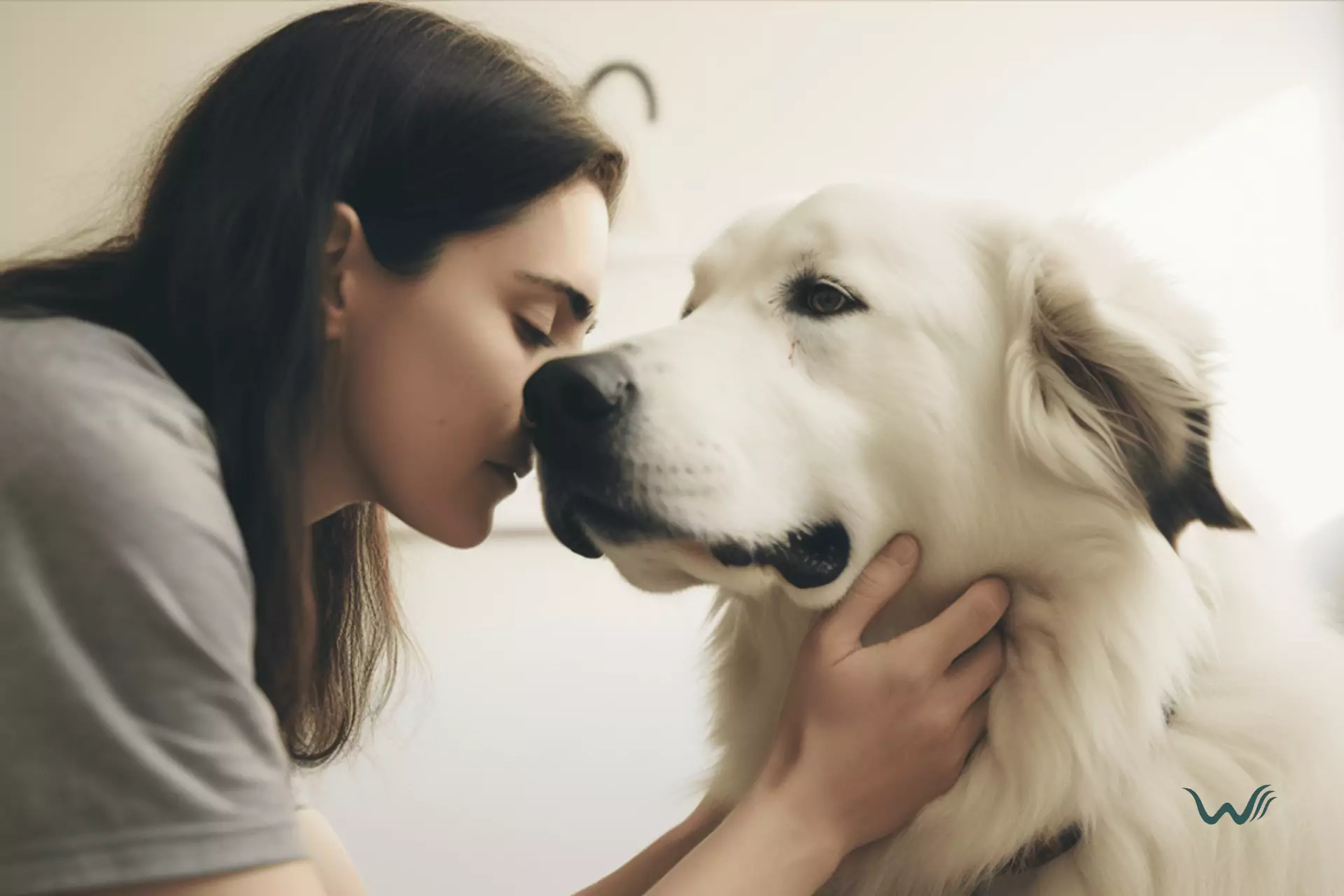

Unleashing Compassion: Positive Skills for Therapy Dogs
by Haley Mills
Last updated: April 20, 2024
Verified and Approved by:
Angela Morris,
MSW, LCSW
Fact Checked

Are you ready to embark on a heartwarming journey filled with wagging tails, wet noses, and boundless joy? Well, get ready, because we’re about to dive into the world of positive reinforcement training for therapy dogs!
These furry heroes are not just your average cuddle buddies; they have a special mission to bring comfort and happiness to those in need. And trust us, their infectious enthusiasm and unwavering devotion will leave you grinning from ear to ear.
Now, you might be wondering, what exactly is positive reinforcement training? Well, my friend, it’s a training method that rewards desired behaviors rather than punishing unwanted ones. And let me tell you, it’s a win-win situation.
It creates a strong bond between you and your furry companion and ensures that they are well-behaved and ready to spread their special brand of joy. So, get ready to buckle up and embark on this pawsome adventure with your therapy dog, because together, you’ll bring smiles and comfort to people’s lives in the most tail-waggingly fantastic way!
Key Takeaways
- Positive reinforcement training is an effective and enjoyable method for training therapy dogs, as it focuses on rewarding desired behaviors.
- Therapy dogs have a special mission to bring comfort and happiness, spreading joy and providing relaxation and stress relief.
- Selecting the right dog for therapy work involves considering factors such as temperament and intelligence.
- Basic obedience training for therapy dogs includes commands like sit, stay, leave it, and touch, while advanced training techniques can include tricks like high five and balancing treats on their nose.
The Benefits of Positive Reinforcement Training
You’ll be amazed at how quickly your therapy dog responds to positive reinforcement training, like a bolt of lightning igniting their enthusiasm for bringing joy and comfort to others.
Picture this: your furry friend, with a wagging tail and a twinkle in their eye, eagerly waiting for the next command. And when they receive praise and rewards for their good behavior, it’s like they’ve won the doggy lottery! Their excitement is contagious, and you can’t help but smile and laugh along with them.
Positive reinforcement training is not only effective, but it’s also a whole lot of fun!
Gone are the days of using harsh methods or punishment to train therapy dogs. With positive reinforcement, you’ll find that your dog is not only motivated to learn, but they genuinely enjoy the process. They’re saying, “Hey, this training stuff is pretty cool! I get to make people happy and get rewarded for it? Count me in!”
And let’s not forget the added benefit of strengthening the bond between you and your furry companion. Through positive reinforcement training, you’ll build trust, communication, and a sense of teamwork. Your therapy dog will become your ultimate sidekick, ready to spread joy and comfort wherever they go.
Selecting the Right Dog for Therapy Work
When searching for the perfect therapy dog, it’s important to consider certain factors that will ensure a successful match.
First and foremost, you need a dog with a heart of gold, one that’s as loving and caring as your favorite grandma. You don’t want a dog that’s all bark and no snuggles, unless you’re looking to scare away the blues instead of spreading joy. So, look for a dog that can give the best cuddles this side of the Mississippi.
Next, you’ll want a dog that’s got the smarts to match its heart. After all, therapy work is no walk in the park (unless you’re actually taking a walk in the park, but you get what I mean). Look for a dog that can learn new tricks and commands easily, because you don’t want to spend all your therapy sessions teaching Fido how to sit and stay.
Basic Obedience Training for Therapy Dogs
Mastering the basic commands is essential for therapy dogs to provide support and bring happiness to those in need effectively. So, grab your treats and get ready for some paw-some training sessions!
Here are four key commands that every therapy dog should learn:
- Sit: This command is the foundation of obedience training. Teaching your dog to sit on command will not only make them look adorable, but it will also help them stay calm and focused during therapy sessions. Plus, it’s a great trick to show off to your friends and family. Just imagine the look on their faces when your furry friend plops down on their bottom with a wagging tail!
- Stay: We all know how excited dogs can get, especially when they’re surrounded by people who just can’t resist giving them belly rubs. But in therapy work, it’s important for dogs to stay in one place and remain calm. Teaching your dog to stay on command will help them maintain their composure and provide a sense of comfort to those they’re helping. It’s like having a furry little zen master by your side!
- Leave it: Let’s face it – dogs are curious creatures. They love to sniff, explore, and sometimes even taste things they shouldn’t. That’s where the “leave it” command comes in handy. By teaching your therapy dog to leave something alone when you tell them to, you can ensure their safety and the safety of those they’re working with. Plus, it’s a great way to prevent any embarrassing moments, like when your dog decides to investigate someone’s lunch!
- Touch: Therapy dogs are all about spreading joy and comfort, and what better way to do that than with a gentle touch? Teaching your dog to touch your hand or another object with their nose on command can be a heartwarming way to connect with those they’re assisting. Whether it’s a high-five, a boop on the nose, or a soft nudge, this command allows your furry friend to bring a little extra love and happiness to those who need it most.
Advanced Training Techniques for Therapy Dogs
What techniques can be used to take your therapy dog’s training to the next level?
Well, first of all, let’s talk about the importance of advanced training. You see, basic obedience is great, but if you really want to spread some serious joy and comfort, you gotta step up your game.
So, here’s a few tricks you can teach your furry friend to make them a therapy superstar.
First off, let’s talk about the classic high five. Sure, it may seem like a simple trick, but when your therapy dog extends their paw for a high five, it’s like they’re saying, “Hey, I’m here to bring some happiness into your life!” Plus, who doesn’t love a good high-five? It’s a surefire way to put a smile on anyone’s face.
Next, let’s move on to the impressive art of balancing treats on their nose. Not only is this trick a great way to showcase your dog’s patience and self-control, but it’s also a great icebreaker. Imagine walking into a hospital room with your therapy dog, confidently balancing a treat on their nose. It’s like a magic show, but with dogs! Trust me, people won’t be able to resist the cuteness overload.
Can positive reinforcement training be used to train both therapy dogs and rescue dogs?
Yes, positive reinforcement for rescue dogs can be highly effective in training both therapy dogs and rescue dogs. By using treats, praise, and toys, trainers can encourage desired behaviors in these dogs while building trust and confidence. This method creates a positive association with training, leading to successful outcomes in their roles.
How Does Positive Reinforcement Training for Traveling with Dogs Differ from Training for Therapy Dogs?
When it comes to training for therapy dogs, the focus may be on obedience and calm behavior in a variety of settings. On the other hand, positive reinforcement for traveling with dogs may emphasize getting your pup comfortable with different modes of transportation and ensuring they have a positive experience on the go.
Spreading Joy and Comfort through Therapy Dog Work
Imagine the heartwarming impact a therapy dog can have as they bring happiness and solace to those in need. These furry companions are trained to provide comfort and support to individuals in various settings, from hospitals to nursing homes and even schools.
Here are some of the ways therapy dogs spread joy and comfort:
- They wag their tails and give endless cuddles, instantly lifting spirits and bringing smiles to faces.
- They have an uncanny ability to sense when someone feels down or anxious, offering gentle nuzzles and unconditional love.
- They provide relaxation and stress relief, allowing individuals to forget their worries and simply enjoy the present moment.
- They encourage social interaction and conversation, acting as a catalyst for meaningful connections between people.
- They bring a sense of normalcy and routine to environments that may otherwise be filled with uncertainty and fear.
Therapy dogs aren’t just trained to provide comfort; they also have a natural talent for spreading joy and laughter wherever they go. Their presence alone can lighten the mood and create a positive atmosphere.
Frequently Asked Questions
How long does it typically take to see results from positive reinforcement training for therapy dogs?
Typically, it takes a little time and patience to see results from positive reinforcement training for therapy dogs. But hey, good things come to those who wait, right? And trust me, the joy and comfort they bring are totally worth it!
Are there any specific breeds that are better suited for therapy work?
When it comes to therapy work, any breed can be paw-some! But some breeds like Golden Retrievers, Labradors, and Poodles are often top dogs for their gentle nature, intelligence, and natural ability to spread smiles.
What are some common challenges owners may face during basic obedience training for therapy dogs?
Regarding basic obedience training for therapy dogs, owners may face a few challenges. From the stubborn pup who thinks they’re the boss to the easily distracted furball, it’s like herding cats sometimes! But with patience and persistence, you’ll both get there.
Are there any additional training techniques that can be used to enhance a therapy dog’s abilities?
To enhance your therapy dog’s abilities, try scent training to help them detect certain scents, or agility training to improve their coordination. Plus, don’t forget the power of treats and belly rubs! These techniques will make your furry friend even more pawsome!
How can therapy dogs help individuals with specific mental health conditions, such as anxiety or PTSD?
Therapy dogs can provide immense support to individuals with anxiety or PTSD. In fact, a study found that spending just 10 minutes with a therapy dog can reduce anxiety levels by 24%! Woof-tastic, right?
Certify Your Emotional Support Animal Today

Why You Can Rely on Us?
At Wellness Wag, we believe your pet deserves care rooted in both science and compassion. Each article is carefully researched, written in clear language for pet owners, and then reviewed by qualified professionals to ensure the information is evidence-based, current, and practical for real-life care. Our goal is to help you feel confident in making informed decisions about your pet’s health and well-being.
Reviewed by
Angela Morris, MSW, LCSW
Angela is a licensed clinical social worker with 20 years of experience in patient advocacy and community mental health. She has assisted numerous clients with ESA evaluations and brings a deep understanding of disability accommodations, ensuring that all information is accurate, supportive, and practical.

Written by :
Haley Mills
Last Updated :
April 20, 2024










